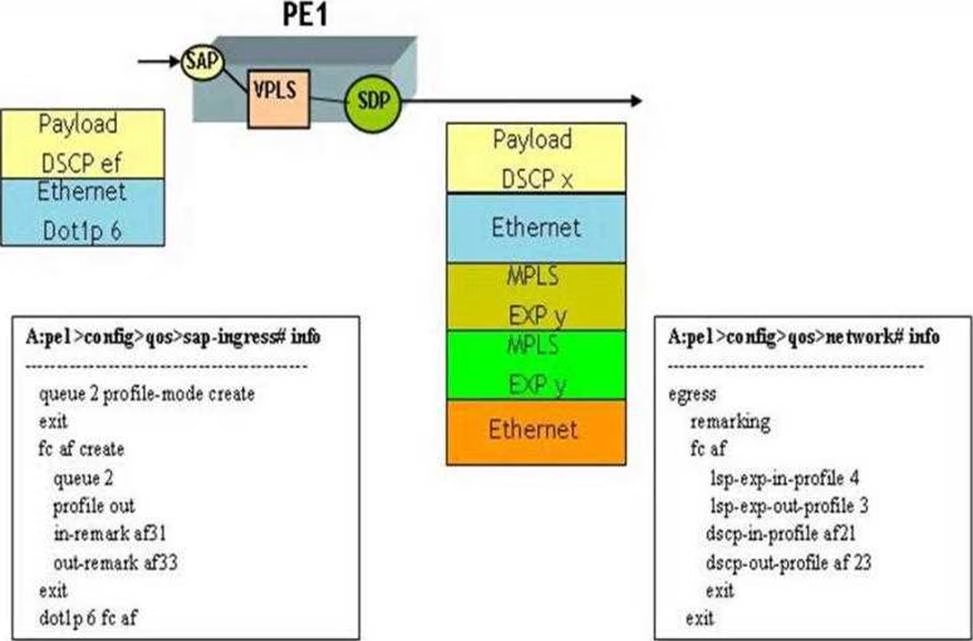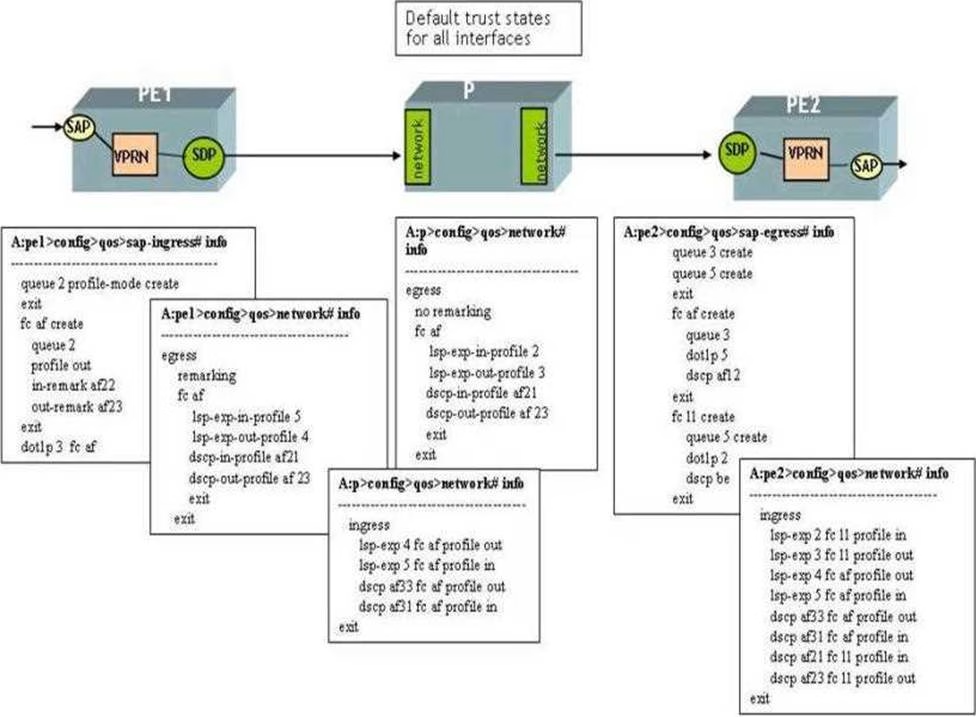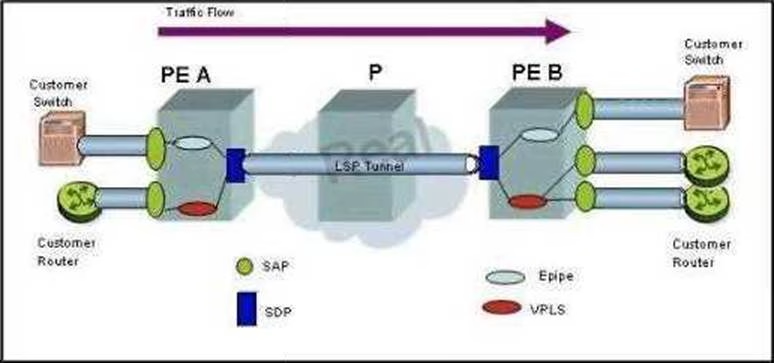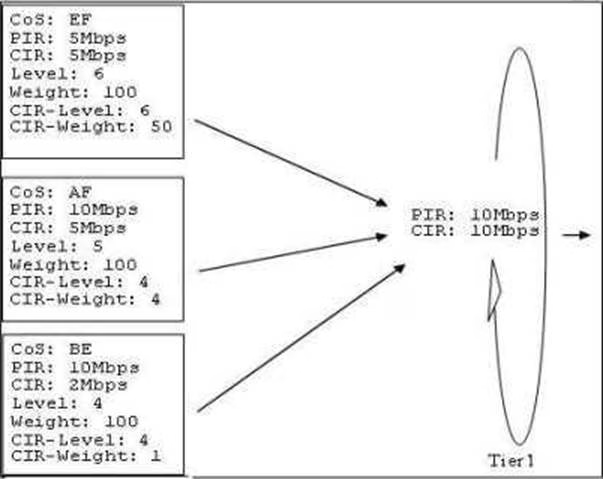Alcatel Lucent 4A0-107 Nokia Quality of Service Online Training
Alcatel Lucent 4A0-107 Online Training
The questions for 4A0-107 were last updated at Feb 20,2025.
- Exam Code: 4A0-107
- Exam Name: Nokia Quality of Service
- Certification Provider: Alcatel Lucent
- Latest update: Feb 20,2025
Which of the following statements regarding scheduling on the Nokia 7750 SR is TRUE? (Choose two)
- A . When using profile-mode queues, traffic that is marked as in-profile on ingress and scheduled in the above-CIR loop will still be considered as in-profile at egress.
- B . When an HQoS strategy using an egress port-scheduler has been deployed, Tier 1 receives its scheduling rates based on the amount of egress bandwidth available for each forwarding class.
- C . The greater the difference between PIR and CIR rates in a queue, the less likely a CIR will be provided.
- D . Packets scheduled out of high-priority queues in the default scheduler will have a lower chance of packet loss at the expense of incurring a higher probability of delay.
- E . When using priority-mode queues, traffic that is marked as in-profile on ingress and scheduled in the above-CIR loop will be considered as in-profile at egress.
Which of the following fields can be marked or remarked for frames belonging to a Layer 2 service?
- A . DSCP
- B . PREC
- C . Dot1p
- D . ToS
- E . Q-in-Q
Click the exhibit button below.

At router PE1, customer packets are arriving tagged with a dotlp value of 6 and marked with a DSCP value of EF.
Based on the configuration shown below for a VPLS service, what will be the DSCP and EXP marking for the packet egressing the network port on this PE router? (Choose two)
- A . The DSCP value will be set to af21.
- B . The DSCP value will be set to af23.
- C . The DSCP value will remain as ef.
- D . The EXP value, in the MPLS headers, will be set to 4.
- E . The EXP value, in the MPLS headers, will be set to 3.
Click the exhibit button below.

All interfaces are using their default trust states and MPLS is used as the transport tunnel. The SAP-ingress, SAP-egress, and network QoS policies have been configured as shown below. Assume that the default network-queue policy is used on each router.
At router PE 1, customer traffic is arriving marked with DSCP BE and tagged with a dot1p value of 3.
Based on the configuration shown below for the VPRN service, what will be the DSCP and dot1p marking for the packet egressing at router PE 2? (Choose two)
- A . The DSCP value will be set to af21.
- B . The DSCP value will be set to be.
- C . TheDSCPvaluewillbesettoaf23.
- D . The DSCP value will be set to af 12.
- E . Thedot1pvaluewillbesetto5.
- F . Thedot1pvaluewillbesetto2.
- G . The dot1p value will be set to 3.
When deploying an Nokia MPLS network with QoS, how are the EXP bits set?
- A . The first 3 bits of the DSCP value are copied directly into the EXP field on the first network egress.
- B . The EXP bits are set on the first network egress, based on a combination of the SAP-ingress classification and the network policy applied.
- C . The 3 priority bits are copied directly from the dot1p header into the EXP field of the first MPLS header.
- D . The EXP bits are set based on a default map that translates DSCP codes into internal forwarding classes on SAP-ingress.
In which policies, on the Nokia 7750 SR. is classification performed? (Choose three)
- A . SAP-ingress policy
- B . SAP-egress policy
- C . IP-criteria policy
- D . Network-queue policy
- E . Slope policy
- F . Network policy
Which of the following are categories of forwarding classes on the Nokia 7750 SR? (Choose two)
- A . Real-time
- B . Assured
- C . Non-conforming
- D . High priority
- E . In-profile
Click the exhibit button below.

The service provider has both a VLL (epipe) service and a VPLS, as shown in the diagram below.
At router PE B, traffic arriving from both services will have the same network-queue policy applied.
- A . TRUE
- B . FALSE
Which of the following statements describe the operation of WRED on the Nokia 7750 SR? (Choose three)
- A . WRED monitors the shared buffer space utilization over a period of time.
- B . WRED disables the TCP slow-start congestion control mechanism.
- C . WRED uses two configurable slopes for each buffer pool: a high slope and a low slope.
- D . WRED uses the shared buffer utilization, instead of the individual queue depth, to get a better picture of the average resource utilization of the shared buffer space.
- E . WRED polices the shared buffer pool and marks all packets above a certain rate as "discard eligible."
Click the exhibit button below.

Given the scheduler-policy (below), which of the following can be done to guarantee that the best-effort traffic receives its configured CIR value?
- A . Change the CIR-level value for the best-effort queue to 8.
- B . Do not change anything; it is already guaranteed to receive its CIR
- C . Change the CIR-level value for the best-effort queue to 1.
- D . Change the CIR-weight value of the AF queue to 0.
Latest 4A0-107 Dumps Valid Version with 231 Q&As
Latest And Valid Q&A | Instant Download | Once Fail, Full Refund

